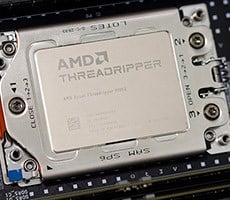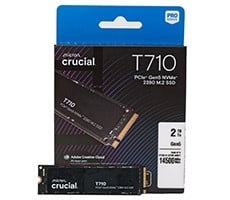AMD Ryzen Threadripper 9980X & 9970X Review: Bountiful Cores, Big Performance
AMD Threadripper 9980X Overclocking - To Be Continued
Overclocking a Threadripper 9000-series processor is essentially identical to previous-gen parts. Because the processors are unlocked, overclocking them is a matter of altering a few multipliers, tweaking voltages, and dealing with the additional heat and power requirements. These processors can also be overclocked by adjusting base clock frequencies too, so it's possible to fine-tune the end result if you like to tinker and go the manual route. However, the easiest way to achieve the most gain will come from using the automatic tools AMD has made available in Ryzen Master.As was the case with the previous-gen Threadrippers, overclocking can be done from within the BIOS on enthusiast-class motherboards or via AMD's Ryzen Master utility, which offers features like Precision Boost Overdrive and Auto-Overclocking. When manually overclocking Threadripper processors, you lose support for features like Precision Boost and essentially lock the processors at a given max frequency, which may actually be lower than the maximum single-core Boost frequency. As such, you may be giving up some single-threaded performance if you manually overclock.
Like previous-gen Ryzen processors though, these new chips support Precision Boost Overdrive and Automatic Overclocking within Ryzen Master, which is a super quick and easy way to increase performance. With PBO, frequencies are dynamically adjusted and automatically managed, and all of the clock gating and power conserving features in the processors continue to function. PBO also reads data embedded in the BIOS by motherboard manufacturers, which defines the maximum power limits of that particular board.
Just tick on PBO in Ryzen Master, crank up the power targets in-line with your motherboard's capabilities and your system's cooling, and overall system performance should be increased without negatively impacting stability. Auto Overclocking works similarly, just flip it on and go—again, assuming you've got adequate cooling. We tried to test both modes (and also enabled PBO via our motherboard UEFI), but upon rebooting the system would hang with 00 post code. We'll revisit overclocking with these chips, once we get to the bottom of things. We assume a BIOS update will get things back on track.
AMD Ryzen Threadripper 9000 Series Review Conclusion
The AMD Threadripper 9000 series is the new king of the HEDT and mainstream workstation CPU markets. Both the 64-core / 128-thread Threadripper 9980X and 32-core / 64-thread Threadripper 9970X offer class-leading performance relative to Intel’s Xeon w series and they represent a significant generational upgrade over the older, Zen 4-based Threadripper Pro 7000 series.The Threadripper 9000 series is clearly targeted at heavily-threaded workloads, but their native support for faster memory and the architectural improvements in Zen 5 also boost single and lightly-threaded application performance, so there’s minimal to no compromises for everyday computing tasks, relative to AMD’s mainstream desktop platform. The Threadripper 9000 series also offers tons of I/O, which will be beneficial for emerging AI developers that may want to run multiple GPUs with full PCI Express bandwidth.
These processors aren’t for everyone and specifically target professionals, AI developers, content creation pros, or the hardest of hardcore enthusiasts. As such, they’re priced at levels that dwarf AMD’s mainstream Ryzen 9000 series. With introductory price points in identical to the Threadripper 7000 series, there will only be a small contingent of folks able to shell out the kind of cash necessary to roll with a Threadripper 9000 platform solution. $5K for the 64-core Threadripper 9980X is big bucks. And $2.5K for the 32-core 9790X is still a big outlay, but less of a jaw-dropper. That said, it’s still 4x the price of a 16-core Ryzen 9 9950X3D and 6x the price of a standard 9950X, for only double the cores. Of course, you also get more IO and double the memory bandwidth, plus some platform benefits, but if we’re strictly talking silicon area, AMD’s charging a healthy premium for these processors. On the plus side, they’re drop-in replacements for the previous gen (after a BIOS/UEFI update), so it’s an easy upgrade for existing 7000 series owners and system integrators.
These are all things we’ve said in the past about AMD's previous-gen Threadrippers, so it shouldn’t be a surprise. If you want to play in the HEDT space, you’ve got to pay. In the end though, we think AMD has another winner in its portfolio with this family of processors. Throughout assembly, configuration, and testing, our Threadripper 9000-test rig behaved exceptionally well. Everything except for overclocking with Ryzen Master worked as expected, performance was excellent, and the system was rock-solid stable. The maturity of TRX50-based motherboards at this point in time basically ensures a smooth experience for early adopters of the Threadripper 9000 series – these motherboards aren’t freshly-minted Gen 1 products anymore.
The bottom line is the Threadripper 9000 series is an incredibly powerful platform. If you’ll benefit from a many-core processor with massive memory bandwidth and tons of IO, there is currently no better solution than the AMD Ryzen Threadripper 9000 series.











